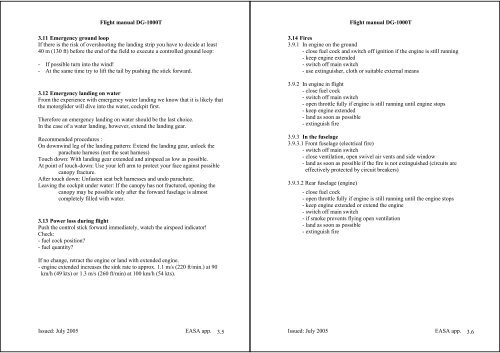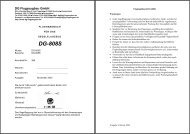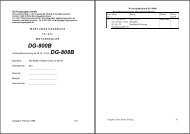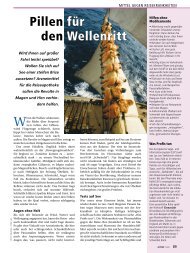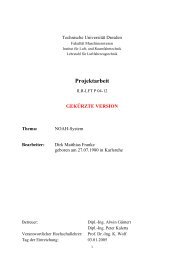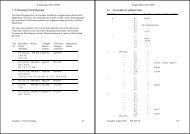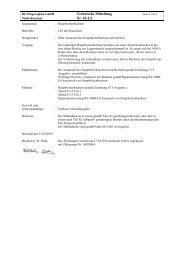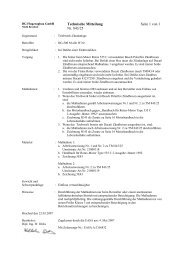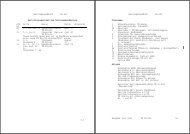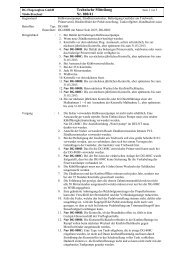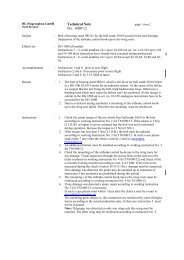DG-1000T - DG Flugzeugbau
DG-1000T - DG Flugzeugbau
DG-1000T - DG Flugzeugbau
Create successful ePaper yourself
Turn your PDF publications into a flip-book with our unique Google optimized e-Paper software.
Flight manual <strong>DG</strong>-<strong>1000T</strong><br />
3.11 Emergency ground loop<br />
If there is the risk of overshooting the landing strip you have to decide at least<br />
40 m (130 ft) before the end of the field to execute a controlled ground loop:<br />
- If possible turn into the wind!<br />
- At the same time try to lift the tail by pushing the stick forward.<br />
3.12 Emergency landing on water<br />
From the experience with emergency water landing we know that it is likely that<br />
the motorglider will dive into the water, cockpit first.<br />
Therefore an emergency landing on water should be the last choice.<br />
In the case of a water landing, however, extend the landing gear.<br />
Recommended procedures :<br />
On downwind leg of the landing pattern: Extend the landing gear, unlock the<br />
parachute harness (not the seat harness)<br />
Touch down: With landing gear extended and airspeed as low as possible.<br />
At point of touch-down: Use your left arm to protect your face against possible<br />
canopy fracture.<br />
After touch down: Unfasten seat belt harnesses and undo parachute.<br />
Leaving the cockpit under water: If the canopy has not fractured, opening the<br />
canopy may be possible only after the forward fuselage is almost<br />
completely filled with water.<br />
3.13 Power loss during flight<br />
Push the control stick forward immediately, watch the airspeed indicator!<br />
Check:<br />
- fuel cock position?<br />
- fuel quantity?<br />
If no change, retract the engine or land with extended engine.<br />
- engine extended increases the sink rate to approx. 1.1 m/s (220 ft/min.) at 90<br />
km/h (49 kts) or 1.3 m/s (260 ft/min) at 100 km/h (54 kts).<br />
Issued: July 2005 EASA app. 3.5<br />
Flight manual <strong>DG</strong>-<strong>1000T</strong><br />
3.14 Fires<br />
3.9.1 In engine on the ground<br />
- close fuel cock and switch off ignition if the engine is still running<br />
- keep engine extended<br />
- switch off main switch<br />
- use extinguisher, cloth or suitable external means<br />
3.9.2 In engine in flight<br />
- close fuel cock<br />
- switch off main switch<br />
- open throttle fully if engine is still running until engine stops<br />
- keep engine extended<br />
- land as soon as possible<br />
- extinguish fire<br />
3.9.3 In the fuselage<br />
3.9.3.1 Front fuselage (electrical fire)<br />
- switch off main switch<br />
- close ventilation, open swivel air vents and side window<br />
- land as soon as possible if the fire is not extinguished (circuits are<br />
effectively protected by circuit breakers)<br />
3.9.3.2 Rear fuselage (engine)<br />
- close fuel cock<br />
- open throttle fully if engine is still running until the engine stops<br />
- keep engine extended or extend the engine<br />
- switch off main switch<br />
- if smoke prevents flying open ventilation<br />
- land as soon as possible<br />
- extinguish fire<br />
Issued: July 2005 EASA app. 3.6


